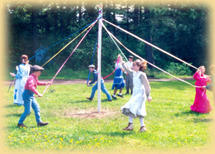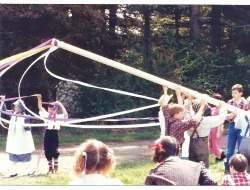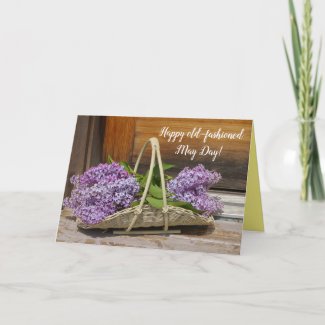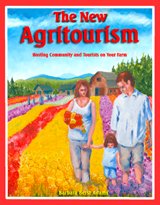Making a May pole, & May pole dancing on May Day
Text and photos copyright National Lilac Publishing, LLC

The May pole dancing tradition and the old-fashioned American May Day celebration in general can be a fun and beautiful custom to restore. Many of us have complained that May Day was turned into a day for angry worker protests when instead it was once a time of celebrating the beauty of nature and sharing it with friends and neighbors. Not to dismiss concerns of the workers (we are also workers), but rather disliking the usage of May 1st for that purpose which shoved aside what May Day once was. So, returning the previous May Day traditions from May Day baskets to dancing around the May Pole as described below, has become a mission for a growing number of people.
Today's May pole renaissance
Schools: Today, this traditional folk dance can be used as a school project, as we used it for an historical re-enactment for elementary students.
Rural weddings: It can be used as a Celtic, Irish or simply old European garden or rural wedding theme, with the bride and groom acting as the traditional May queen and May king.
Families: It can be used as a fun theme for a spring family reunion.
Agritourism: Rural folks, small-scale farm owners and micro eco-farmers can use it as an agritourism attraction that draws customers to the farm and rural community. Our rural May Day celebration with its May pole dancing drew media and public attention from 150 miles away. Spoutwood Farm started out celebrating May Day with about a hundred friends, and the festival turned into one that attracted thousands of paying guests. The print book, The New Agritourism: Hosting Community & Tourists on Your Farm describes this and many more ways to earn income with folk traditions and fun rural group activities.
Revived ancient spiritual: It can also be a quiet and simple spiritual celebration.
May pole dancing
One of the earliest recordings of American colonists celebrating May Day with May pole dancing is in 1622. The May pole dance starts with a tall post with an even number of brightly colored ribbons attached to the top. The ribbons’ lengths reach the ground where they are unattached to anything.
Each ribbon’s ground level end is held by one person, and the group of dancers, one for each ribbon, can be any group of kids and adults and any gender. Or, it can follow a tradition of being half boys, half girls, surrounding the pole in boy/girl order. The boys lift their ribbons while girls carry their ribbons under the boys’, and visa versa, weaving under and over until the entire pole is woven from the top down in a beautiful pattern. The cooperation of boys and girls together, as equals, to make a beautiful new piece of art is admirable and always mesmerizes the onlookers.

Making the May pole
In a past era, plants from the woods were plentiful, and the specific tree chosen for the May pole had a deep meaning. Today, some country folks may be able to choose lodge poles or other wooden poles already down and free from branches that can then be unwrapped after the festival is over, and used for its original purpose. In other cases, tall outdoor lights mounted on straight posts have been used as the May pole, leaving the ribbons up for a week or so after the dance is over.
You may want to try our version. Someone donated two lightweight white four-inch diameter PVC pipes about five feet long, which we connected to make a 10 foot post. Then, we purchased ribbon about 11 feet long and about two inches wide in 8 to 10 different colors (number depending on how many dancers at a time we planned to have that year). It’s best if each ribbon is a different color. I found quality ribbon that wide and long from fabric stores was far too expensive for this project, and purchased ours instead at a local party rental shop, where they were more inclined to sell less expensive decorative items in large quantities for temporary purposes such as parades and weddings. The ribbon’s quality from this store worked well for the dance, and was sometimes used for a few years in a row before becoming too ragged.
Don’t make this mistake: Our first attempt at a May pole dance was to try using ribbons of brightly colored crepe paper streamers instead of ribbon. Didn’t work. The paper broke far easier than we imagined, and even when we managed to get a little bit of a weave from it, it didn’t lay nicely as it was being braided down the pole. An ounce of spring rain also would have deteriorated it into a mess of running dye and mush. But, if this is a one-day sunny event, paper or ribbon flowers can be made to decorate the very top of the May pole where the stronger streamers are attached before lifting the pole into place.
While the pole was lying on the ground near where the dance would be held, a selected group of children were given the task to securely tape the ribbons to the top with duct tape. Try taping down inside the tube rather than allowing the tape to show on the outside (thus the extra foot of ribbon). An adult can check to make sure it’s very secure. Though no one is supposed to purposely tug hard on the ribbon, there is incidental and accidental pulling during the dance.
A hole about a foot deep can be dug with a post hole digger. We
had several young kids lift the pole into place, filling in soil and
tamping around its base to make it snug. This, obviously, made the pole a
little shorter, and therefore the ribbon already now a little longer,
but this seemed to be a good length combination for both of them. WARNING: Once the May pole is removed, immediately fill up this hole, tamping it down solid. These types of holes are ankle breakers for both people and horses, being narrow, deep, and hard to see.
More on May pole dancing
Previously to this larger festival, with very young kids ages three to five, we simply had them walk slowly around a shorter pole with their ribbon, all in the same direction, and let them basically just twist the ribbon down the side lower and lower until they covered the pole. With different colored ribbons, it did make a pretty decoration the kids were proud of.
But for adults or older kids, the classic May pole dance calls for half of the dancers to go in one direction, half in the other, first ducking under another dancer, then lifting their ribbon over the next dancer. The resulting weave on the May pole is quite beautiful.
Practicing the Dance
If one half of the dancers are boys, and the other girls, this automatically determines the halves that go in one direction or the other. But large mixed gatherings may have several groups that all want to try to dance (meaning either having more than one pole or unwinding the first group’s to give another group a chance) and your dancers could be a mix of adults, teens, and older kids without a perfect split between the genders. For the directions given below, I’ll describe it as “boys and girls,” but adapt it by determining upfront which half of your dancers will go in which direction.
It sounds easy at first. What could be more simple, boys go in one direction, girls go in another, and they take turns going over and under.
This attitude is dangerously close to leading you into the same thing that happened to us at our first attempt in which we didn’t practice at all. Darling children in quaint costumes started the dance, live music playing, with eager parents flipping on their video recording machines to what became a chaotic, body crashing confusion with the teacher yelling over the sound of the music, tangled children looking around in shock and parents one-by-one turning off their video recorders. Do a quick practice first.
Have the kids line up, all boys in one line, and all girls in another, (as though they’re going to play a game of tug of war, girls against boys.) Put about five feet between each child in line. Starting with the lead girl, have the boys stay still and the girls line weave in and out between each boy until they’re all through the line. Stop. Then have the boys do the same with the girls.
Then, have the two lines start as they did before (tug of war), but do the weaving simultaneously, no one staying still, without getting confused, until they’ve made it through to the end.
Once they've conquered that concept, put them in a boy-girl-boy-girl... circle, with each child standing about five feet apart, and have them try to weave continuously and see if they can maintain that momentum.
Once this seems easier for them, they can try it while holding
and keeping a ribbon’s slack just right for weaving it on the pole.
Music for May pole dancing
The dance is traditionally accompanied by a musician using string, pipe, bagpipe or bell instruments, improvising a flowing sound and rhythm that accompanies the movement of the dancers. The musician interprets the dance, rather than the dancers trying to interpret the music at the same time they’re trying to braid a May pole.
When the May pole dancing is complete
Once the weaving is complete, various traditions suggest now is the time to enjoy a May feast or make and deliver May baskets. Some leave the woven ribbons on the pole for the entire month of May similar in fashion to decorating and keeping up the Christmas tree. Other traditions make unweaving the pole as significant as weaving it, with the dancers reversing their movements.







